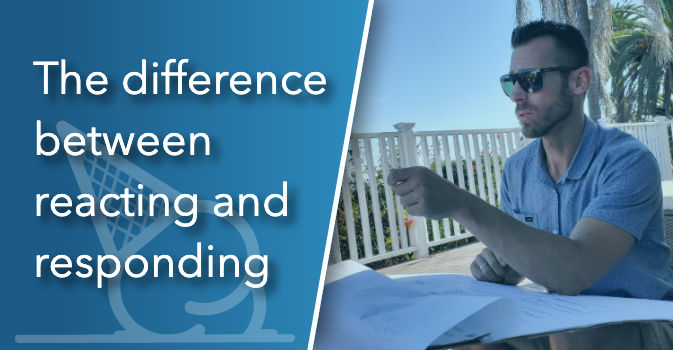The difference between reacting and responding
What do you do when something goes wrong?
I’ll tell you what I do in a minute, but first, think about what you do.
Before you answer, think about how many times in a single day something goes wrong.
Maybe not terribly wrong, but from the unexpected, to the unbearable, how many times do things not go your way?
Probably a lot. And in business, the entire goal of your competition is to make things not go your way.
So in those moments, you have a choice of two things: you can react, or you can respond.
“Reacting” is what most people do most of the time.
It’s choosing to act on our initial impulses.
Impulses are non-voluntary. Something makes us mad, sad, frustrated, disappointed, depressed, we can’t help feeling that way. The impulse is okay by itself.
The problem is that most people then act on that impulse. And “acting” on an impulse is always physical. Our body language or verbal language is how we choose to express our impulsive emotion.
So we stomp our feet, throw our arms out, yell, roll our eyes, slump our shoulders, slam our laptop closed, or say something not so nice.
Those are reactions. When we react, we aren’t in control.
On the other hand, a “response” is a pre-decided choice.
It’s how we have decided we will act when something we’re already preparing for doesn’t go our way.
It’s deciding ahead of time that you’re going to encourage your sales rep after a dropped deal, huddle your team for the next month with confidence after a missed goal, hold your head up and face straight when you fumble an opportunity.
A response is the choice of leaders. A reaction is the impulse of a child (no matter how old we are).
So think about 3 things that are highly likely to go wrong this week. You know what they are. They are common mistakes that happen as a entrepreneur – lost deals. Missed deadlines. Tech issues. Short cashflow.
(Why do we seem so surprised by these things when they happen all the time, anyway?)
And visualize how you want to respond to those scenarios. See yourself acting the way you would want yourself to act to have people respect you the way you want to be respected.
Now, pre-record that response in your brain, and when the time comes, and it will come, acknowledge your impulse to throw a fit, shout or yell, or slump your shoulders and feel sorry for yourself, and then choose to ignore your impulse and select your already-recorded response.
The response that makes you look like a real leader.
Because if you’re going to be a real leader, you have to act like a real leader which means you to have to prepare ahead of time to act like a leader when stuff goes wrong.
Think about it. Apply it this week and see how you feel and what it gets you.
Oh, I promised you I’d tell you what I do when something goes wrong. Well, as a leader of a lot of people, a lot of revenue and expenses, as well as my own family, I can tell you things don’t go the way I want every single day.
I do three things:
- Prepare ahead of time for surprises so I’m not surprised.
- If I need to be angry, or sad. I do it alone then get myself back together.
- I project calm confidence. Then I prepare better to not let it happen again.
I hope that’s useful for you. If you try it out, I know it will be.
Editor’s Note: Fun fact – Justin originally wrote this blog post as an email to his list for a business he runs training youth quarterbacks, but when I read the email I felt like the parallels for small business were uncanny, so I adapted it. Just reread it and replace the word “business” with “football” and you’ll see it works for that lens too.








It’s a great post! I’m always amazed at what comes out of this guy’s head. Thanks for sharing this nugget, Greg!
The man can’t help but ooze wisdom. It’s a compulsion – he needs help.
Fun game- try to identify an area of your life where Justin’s words *don’t* apply.
I couldn’t.
Hahaha, great point.
Brilliant article – so relevant to all our relationships.
Poignant, right?
Love this! I am dealing with a few things in the business that I now realize I have been tolerating and reacting to…
Long story short… trying to launch a product that I think will hit big. My partner is working for sweat equity (aka – not much has been happening for the last long time). Recently, I have felt the urge to take my product over the finish line even if it means to do it myself from scratch. I decided to have the hard conversation with my partner, and now next Thursday is our ultimatum conversation.
I have come to terms with either outcome… either we hit a deliverable, or we don’t. Either we take steps forward or we don’t. My previous reaction has been that my hands are tied, but now… my response mindset is taking me to reach out to other devs, skill up on my rusty coding, and start to create my default future.
Thank you JMac and thank you Greg for getting this out there! Even though my next steps (or end result) is foggy at best now… moving forward into the fog is 100% better knowing that I am responding and not reacting. Here’s to controlling the “uncontrollables!”
Bingo. If you don’t change it, you choose it.
Pausing mid-article to comment. I closed my eyes to think of 3 things that will go wrong. This is already a really useful exercise. I feel so much better prepared for those things.
I’m getting some work done from home today, and while I was thinking, my daughter yelled “Daaaaad!” for the 800th time. Rather than react, I responded, “Yes, sweetheart?” and she said, “I love you.”
Oh dang. Glad I didn’t simply react!